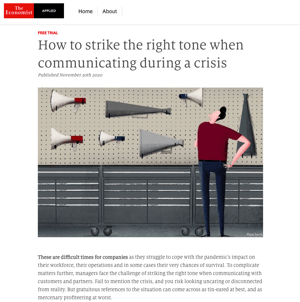 As published in The Economist on November 30, 2020. As published in The Economist on November 30, 2020.
These are difficult times for companies as they struggle to cope with the pandemic’s impact on their workforce, their operations and in some cases their very chances of survival. To complicate matters further, managers face the challenge of striking the right tone when communicating with customers and partners. Fail to mention the crisis, and you risk looking uncaring or disconnected from reality. But gratuitous references to the situation can come across as tin-eared at best, and as mercenary profiteering at worst.
Even at the best of times, there is a “shoot the messenger” tendency to blame the comms team when things go wrong, says Janie Jordan, a specialist in crisis communications based in New South Wales. The rise of social media and “cancel culture” make corporate missteps even more dangerous. Some communications experts see a silver lining, however. Bosses may be more willing to try something new during a crisis, opening up new opportunities, says Christopher Britton, co-founder of RockDove Solutions, a corporate-communications firm based in Maryland. So what are the dos and don’ts when it comes to communicating in difficult times?
- Steer clear of pandemic “newsjacking”. In a bid to garner attention and secure media coverage, companies often try to link promotional activities to breaking news. But if they are perceived to be exploiting the situation (“Stuck at home? Buy some leisurewear!”) consumers will think “Whoa, that’s not alright”, says Hervé Cacheur of Sharing, a communications agency based in Paris. It may be counter-productive in another respect: “pandemic fatigue” appears to be sapping interest in media reports that reference covid-19 in any case.
- Provide practical, factual information, rather than a sales pitch. Communications should be led by “purpose rather than product”, says Parul Soni, a partner at Thinkthrough Consulting, an advisory firm based in Delhi. Rather than tout a new investment vehicle, for example, a financial firm might instead write a press release offering advice on convincing creditors to reschedule payments.
- Reflect before crowing about community engagement or charity. If your firm has bad news, such as employees who have died of covid-19, announce that first. Charity activities should only be mentioned separately and later, lest the juxtaposition appear crass. Some will view a donation, by itself, as tokenism. “You can’t just write a check these days”, says Terry Hemeyer, a communications professor at the University of Texas, Austin, who has advised American presidents. Get staff involved in charitable activities, he says, and highlight that in your PR.
- Avoid navel-gazing. Messaging must address what matters to recipients, Mr Soni notes, not the sender. At a time when suppliers may be worried that orders will dry up or payments will be delayed, sending season’s greetings or fluff about your firm’s centennial will merely annoy people.
So much for the content. What about tone? The pandemic has also increased the importance of how messages are conveyed. The experts we spoke to suggest the following:
- Respond quickly if a problem pops up, even if only to say that your company is gathering facts for a forthcoming update; in the social-media era, informational voids can fill fast with falsehoods.
- Be reassuring. In difficult times, business leaders should exude competence and, where appropriate, compassion. The latter can be difficult to convey through the written word, so don’t neglect spoken messages, says Jonathan Bernstein of Bernstein Crisis Management in Colorado. He advises firms to use filmed messages and, with important stakeholders, video calls.
- Convey authenticity. Overuse of buzz-phrases signals insincerity, not to mention laziness. So steer clear of “pivot”, “new normal”, “in these unprecedented times”, “out of an abundance of caution”, “now more than ever” and other clichés. And since personal circumstances vary dramatically, refrain from claiming that everyone is in the same boat.
- Attempts at coronavirus humour and wordplay are risky. Coca-Cola and McDonald’s are among brands that have run campaigns with their logos tweaked to convey social distancing. (The former spaced out the lettering; the latter separated its golden arches.) Even that struck “a sour note”, as the editor of Ad Age told CNN.
Another source of risk is that processes around communication will be disrupted or circumvented in a crisis. So what should you watch out for?
- Beware the authoritarian opportunist. Businesses in crisis often see a dominant personality hijack the confusion and “adrenaline of the moment” to seize the megaphone and dictate a new approach to communications, Mr Britton says. The resulting concentration of power can lead to blunders, such as...
- Don’t stray into politics unless you mean it. When checks on a communicator’s power fall away, political statements are more likely to crop up. To avoid partisan rancour, keep your company’s statements from appearing to mirror a particular political party’s positions, advises Mr Britton. And if a company is going to take a political position, it should do so deliberately.
- Beware of the crisis within a crisis. Public-relations folks often assume that an emergency will follow a predictable trajectory “from crisis through fire-fighting to business as usual”, says Mr Bernstein. With the pandemic grinding on and activism soaring, he says, that’s no longer the case, and the situation is far more fluid. To keep an eye out for unexpected problems, monitor news outlets and social media closely, and set up automated alerts based on company-specific keywords.
Finally, over-prepare for the unexpected. Organisations that have avoided communications slip-ups so far may feel they have little to fear. But complacency is dangerous. So brainstorm for ways the pandemic could cause a PR emergency for your company, whether by missteps, bad luck, or malicious disinformation. Then “war game” the scenarios to better prepare for the real thing.
|